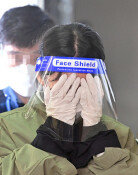Nat`l Museum of Korea to Attract 10 Mlnth Visitor
Nat`l Museum of Korea to Attract 10 Mlnth Visitor
Posted May. 16, 2009 21:57,
The National Museum of Korea is expected to attract its ten millionth visitor soon since its move to Seoul`s Yongsan district in October 2005.
The number of visitors reached 1,339,709 in the first three months. In 2006, 3,287,895 people visited the museum but the figure fell to 2,281,700 in 2007.
Given that the museum allowed visitors to look around the museum for free, the number of visitors failed to fall more last year in rising to 2,283,425. Considering that certain people visited the place several times, an estimated one-fifth of the population has visited the museum over the past few years.
A walk of more than four kilometers is needed to see all the galleries of the museum. More than 11 hours are needed to look at 12,000 pieces of exhibits displayed at the museum.
After two or three hours of looking, visitors often complain of "museum fatigue" that weakens their concentration. Lee Won-bok, in charge of curatorial affairs for the museum, suggests an efficient way to enjoy the museum.
Enter the first stage and walk along the Path of History to find exhibition halls for the Bronze Age, Early Iron Age and Goguryeo era on the left side. At the exhibition halls is also a bronze plate showing prehistoric people who plowed fields with farming devices and sowed seeds thousands years ago.
In the exhibition hall of Goguryeo, an ancient tomb mural painted on the wall of Ssangyeongchong (located in North Pyongan Province in present-day North Korea) is displayed, signifying a tomb with two pillars.
The mural, which depicts a person on the back of a horse, is the only authentic one of its kind from the Goguryeo era and kept by South Korea.
Head for the exhibition hall of Baekje to find an ancient gilt-bronze incense burner. This is an imitation of an authentic incense burner kept by Buyeo National Museum but retains the beauty of Baekjes fine arts.
At the exhibition hall of Gaya, visitors can see Gayas strong iron culture through suits of armor and war helmets, which disprove Japans argument that it controlled the southern part of the Korean Peninsula in ancient times.
The entrance of Shilla Exhibition Hall houses a gold crown (National Treasure No. 191) and a gold girdle (National Treasure No. 192) found at Hwangnamdaechong. The owner of the gold crown was a queen, not a king.
Other relics deserving attention at the exhibition hall include two pieces of earthenware in the form of a warrior on horseback (National Treasure No. 91). The bigger one and the smaller one describe the master and servant, respectively.
Leaving Shilla Exhibition Hall takes one to Gyeongcheon Temples 10-storied marble pagoda (National Treasure No. 86). After being returned to Korea, the pagoda, which was taken to Japan during Japanese colonial rule of the Korean Peninsula, was destroyed while at Gyeongbok Palace.
Passing through the pagoda brings one to National No. 3 Bukhansan Shilla Jinheungwang Bi, a monument commemorating the border inspection of King Jingheung. This is located at the Inscriptions Exhibition Hall of the Historical Gallery.
The Maps Exhibition Hall displays a wooden platter on which mountains and water are engraved. The platter was used to print Daedongyeojido, a map projection.
If one returns to the 10-storied marble pagoda and takes the escalator heading for the second floor, he or she can see the upper part of the pagoda that is 13.5 meters tall.
Danwon Kim Hong-dos genre paintings (Treasure No. 527) are displayed at the exhibition hall of the Paintings of Fine Art Gallery I. Stroll along the Fine Art Gallery I to find Treasure No. 1340 Cheoneun Temples Gwaebul, a nine-meter painting depicting the Buddha.
One need not struggle to closely watch the upper part of the painting on the second floor, as the third floor is available for viewing.
At the Buddhist Sculpture Exhibition Hall of Fine Art Gallery II on the third floor, a visitor can see Koreas largest iron Buddha with a height of three meters. National Treasure No. 78 is Geumdongbangasayusang, a gilt-bronze Maitreya in meditation.
A water bottle made of porcelain (National Treasure No. 92) displayed at the exhibition hall of metal arts of Fine Art Gallery II proves that the Goryeo Kingdom had advanced metal art skills.
At exhibition halls displaying Koreas ceramic ware, three rabbits draw attention. They prop up an incense burner made of Goryeo celadon (National Treasure No. 95). National Treasure No. 94 in the shape of a melon shows the perfect balance between straight lines and curves. The strings engraved on the surface of the white porcelain bottle look like real strings.
National Treasure No. 166, a white porcelain jar with plum and bamboo patterns, is often seen as a beautiful painting.
Following the recommended course can finish a museum tour in 90 minutes. Outdoor exhibitions displaying stone cultural assets are also good to visit. Seven dolmens located in Sancheong, South Gyeongsang Province, will also be moved to the museum soon.
The museum will give a gold crown worth 320,000 won (253 U.S. dollars), a replica of the one found at Cheonmachong, and the list of exhibits displayed at the museum to its 10 millionth visitor.
Ten people who visit the museum before and after the 10 millionth visitor will also be given tickets for Cleopatra, a musical commemorating the museums Egypt, the Great Civilization exhibition, and a list of the museums top 100 exhibits.
zeitung@donga.com







